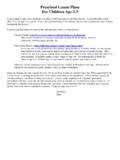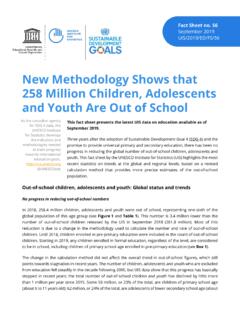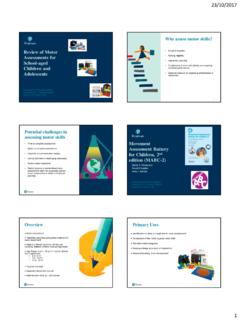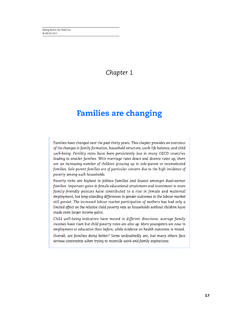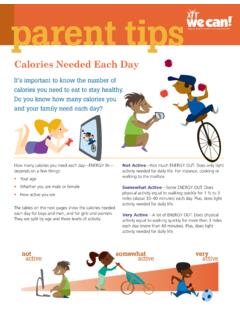Transcription of Children Are Not Coloblind: How Young Children Learn Race
1 1 All rights reserved. PACE Vol. 3- No. 3 | 2009 HighReach Learning Inc. Children Are Not Colorblind: How Young Children Learn RaceErin N. Winkler, University of Wisconsin-MilwaukeeThere is a myth in popular culture that Young Children are colorblind or don t notice race. By this logic, Children are blank slates who cannot develop racial prejudices until they are explicitly taught to do so. This leads many adults to argue that we should not discuss race with preschoolers because they are too Young , and even mentioning race will put ideas in their heads or poison their minds. When Young Children talk about race or express any bias, it is often either dismissed ( She doesn t know what she s saying. ), blamed on parents or other adults ( Someone must have said that at home.)
2 , or only indirectly addressed as general bad behavior ( We don t say things like that because it hurts people s feelings. ). However, current psychological research suggests this approach is all wrong. In fact, research clearly shows that Children not only recognize race from a very Young age, but also develop racial biases by ages three to five that do not necessarily resemble the racial attitudes of adults in their lives (Aboud, 2008; Hirschfeld, 2008; Katz, 2003; Katz & Kofkin, 1997; Patterson & Bigler, 2006; Van Ausdale & Feagin, 2001). This research suggests that we must rethink what we know about Young Children and race. What do Children Learn , and when? In a study that followed approximately 200 black and white Children from the ages of six months to six years, Katz and Kofkin (1997) found that infants are able to nonverbally categorize people by race and gender at six months of age.
3 The infants looked significantly longer at an unfamiliar face of a different race than they did at an unfamiliar face of their same race. The researchers argue that, because this finding is very consistent in six-month-olds, initial awareness [of race] probably begins even earlier (Katz & Kofkin, 1997, p. 55). Toddlers as Young as two years use racial categories to reason about people s behaviors (Hirschfeld, 2008), and numerous studies show that three- to five-year-olds not only categorize people by race, but express Research clearly shows that Children not only recognize race from a very Young age, but also develop racial biases by ages three to rights reserved. PACE Vol. 3- No. 3 | 2009 HighReach Learning based on race (Aboud, 2008; Hirschfeld, 2008; Katz, 2003; Patterson & Bigler, 2006).
4 In a yearlong study, Van Ausdale & Feagin (2001) found that three- to five-year-olds in a racially and ethnically diverse day care center used racial categories to identify themselves and others, to include or exclude Children from activities, and to negotiate power in their own social/play and why does this happen? Research has disproved the popular belief that Children only have racial biases if they are directly taught to do so. Numerous studies have shown that Children s racial beliefs are not significantly or reliably related to those of their parents (Hirschfeld, 2008; Katz, 2003; Patterson & Bigler, 2006). While this may seem counterintuitive, Hirschfeld (2008) says it should not surprise us. Children , he argues, are motivated to Learn and conform to the broader cultural and social norms that will help them function in society.
5 In order to gauge these community norms, Children have to gather information from a broad range of sources not just their own families. He gives the example of accents as a way of illustrating his point. If Children looked only or even mostly to their parents to Learn behaviors and norms, then we would expect Children of nonnative speakers to acquire their parents accents. Instead, Children acquire the normative accent of the region where they are growing up (Hirschfeld, 2008). So, Children collect information from the world around them in order to actively construct their own beliefs (Patterson & Bigler, 2006). But why do Children form racial biases so early in life, even if no one around them is teaching them to do so? And why is race a social category to which they attach meaning?
6 Why not height or hairstyle or left-handedness? Scholars argue that there are both internal (biological and cognitive) and external (environmental and societal) factors at play. First, the immature cognitive structures of preschoolers make them rife for stereotyping (Aboud, 2008; Hirschfeld, 2008; Katz & Kofkin, 1997). While Young Children are able to categorize people by race, they are often not able to categorize a person according to multiple dimensions at once (Aboud, 2008). Thus, they engage in transductive reasoning when they see people who are alike in one dimension ( , skin color), they presume they are alike in other dimensions as well ( , abilities or intelligence) (Katz & Kofkin, 1997; Patterson & Bigler, 2006). Second, factors in Children s environments, and in our society as a whole, teach Children that race is a social category of significance.
7 Bigler and her colleagues found that environments teach Young Children which categories seem to be most important (Bigler & Liben, 2007; Patterson & Bigler, 2006). Children then attach meaning to those social categories on their own, without adult instruction. Patterson and Bigler (2006) argue that even a seemingly innocuous statement like, Good morning, boys and girls, helps Children infer that gender is an important social category, and Children can then attach their own meanings to gender categories ( , Girls are smarter. ), or infer them from their environment ( , Only men can be President of the United States. ), even if adults do not mention or endorse those ideas. 3 All rights reserved. PACE Vol. 3- No. 3 | 2009 HighReach Learning also Learn which social categories are important by observing their environments.
8 They are likely to notice that the people in their families or neighborhoods are all different heights and have different hairstyles, but perhaps almost all have the same skin color. Therefore, Children may assume that they should avoid or dislike people with different skin colors than their own, even if no adult ever says this to them (Aboud, 2005). Similarly, Children may notice when going to the store or the doctor s office or riding the bus that height and hairstyle do not seem related to occupation or neighborhood, but skin color does. These patterns form what Bigler & Liben (2007) call a cognitive puzzle for Children to solve (p. 164). When Children notice these patterns, they often infer that these are norms or rules (Aboud, 2008, p. 58) and that the patterns must have been caused by meaningful inherent differences between groups (Bigler & Liben, 2007, p.)
9 164). Although Children often attach meaning to race without adults directly telling them to do so, it is important to note that the biases Children exhibit are not random (Katz & Kofkin, 1997, p. 62). In fact, they often reflect both subtle and not so subtle messages about the relative desirability of belonging to one social group as opposed to another (Katz & Kofkin, 1997, p. 62). In other words, Children pick up on the ways in which whiteness is normalized and privileged in society. What does this mean? Consciously or unconsciously, middle-class white culture is presented as a norm or a standard in the United States in terms of appearance, beauty, language, cultural practices, food, and so on (Johnson, 2006; McIntosh, 1990; Tatum, 1997). Tatum (1997) argues that this message is so prevalent in our society it is like smog in the air.
10 Sometimes it is so thick it is visible, other times it is less apparent, but always, day in and day out, we are breathing it in (p. 6). For very Young Children , this smog comes in the form of picture books, Children s movies, television, and Children s songs, which all include subtle messages that whiteness is preferable (Giroux, 2001; Graves, 1999; Katz, 2003; McIntosh, 1990; Murray & Mandara, 2002; Tatum, 1997). Even the language and symbolism we use daily tends to associate positive things with white ( , purity, clean, Snow White, the good witch ) and negative things with black ( , evil, sin, dirty, the wicked witch ), and studies have shown that Children do generalize these linguistic connotations to people (Katz, 2003; Tatum, 1997). Researchers have found that even very Young Children develop what psychologists call in-group bias, or favoritism towards the groups in which they are members (Patterson & Bigler, 2006).



